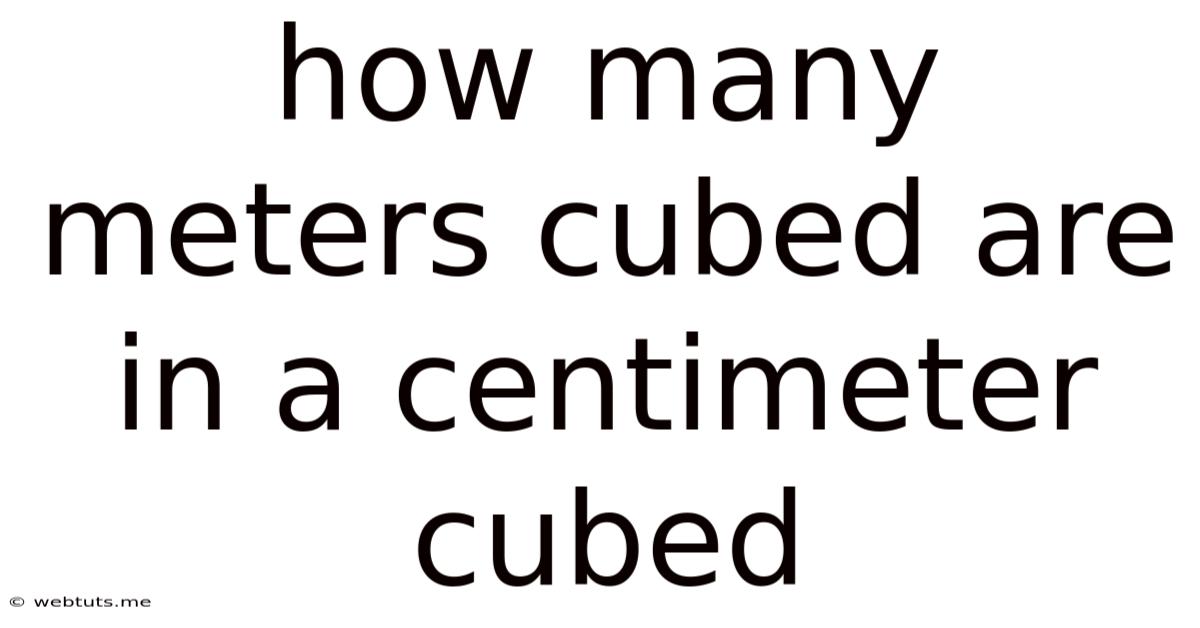How Many Meters Cubed Are In A Centimeter Cubed
Webtuts
Mar 31, 2025 · 4 min read

Table of Contents
Unraveling the Cubic Centimeter to Cubic Meter Conversion: A Comprehensive Guide
Understanding unit conversions is fundamental in various fields, from engineering and physics to everyday life. One common conversion that often causes confusion is converting cubic centimeters (cm³) to cubic meters (m³). This seemingly simple conversion requires a clear grasp of cubic units and the metric system. This comprehensive guide will not only explain how many cubic meters are in a cubic centimeter but also delve into the underlying principles, provide practical examples, and offer strategies for avoiding common mistakes.
Understanding Cubic Units: Beyond Linear Measurement
Before diving into the conversion, it's crucial to understand the concept of cubic units. While linear measurements (like centimeters and meters) measure length in a single dimension, cubic units measure volume, which involves three dimensions: length, width, and height.
Imagine a cube with sides of 1 centimeter each. Its volume is 1 cubic centimeter (1 cm³). Now, imagine a much larger cube with sides of 1 meter each. Its volume is 1 cubic meter (1 m³). The key difference lies in the scale—a meter is significantly larger than a centimeter.
The Conversion Factor: Bridging the Gap Between Centimeters and Meters
The fundamental relationship between centimeters and meters is that 1 meter = 100 centimeters. This seemingly simple equation is the key to unlocking the conversion between cubic centimeters and cubic meters. However, because we're dealing with volume, which is three-dimensional, the conversion isn't as straightforward as simply multiplying by 100.
Since a meter is 100 times larger than a centimeter, a cubic meter (a cube with sides of 1 meter) contains 100 x 100 x 100 = 1,000,000 cubic centimeters. Therefore, the crucial conversion factor is:
1 m³ = 1,000,000 cm³
This means that one cubic meter is equivalent to one million cubic centimeters. Conversely, 1 cm³ = 0.000001 m³.
Practical Applications and Examples: Putting the Conversion to Work
Let's illustrate this conversion with some practical examples to solidify your understanding:
Example 1: Converting a Small Volume
Imagine you have a container with a volume of 500 cm³. To convert this to cubic meters, we use the conversion factor:
500 cm³ x (1 m³ / 1,000,000 cm³) = 0.0005 m³
Therefore, 500 cubic centimeters is equal to 0.0005 cubic meters.
Example 2: Converting a Larger Volume
Let's consider a larger volume, say, 25,000 cm³. Applying the same conversion:
25,000 cm³ x (1 m³ / 1,000,000 cm³) = 0.025 m³
Thus, 25,000 cubic centimeters is equivalent to 0.025 cubic meters.
Example 3: Working Backwards (Cubic Meters to Cubic Centimeters)
Sometimes you might need to convert from cubic meters to cubic centimeters. Let's say you have 0.1 m³. To convert this to cubic centimeters:
0.1 m³ x (1,000,000 cm³ / 1 m³) = 100,000 cm³
So, 0.1 cubic meters is equal to 100,000 cubic centimeters.
Avoiding Common Mistakes: Precision and Unit Consistency
While the conversion itself is straightforward, several common mistakes can lead to inaccurate results:
-
Incorrect Power of 10: The most frequent error is misplacing the decimal point or using an incorrect power of 10 when converting between cubic centimeters and cubic meters. Remember the crucial factor: 1,000,000.
-
Confusing Linear and Cubic Units: Don't confuse linear measurements (centimeters and meters) with cubic measurements (cubic centimeters and cubic meters). The conversion factor is different for each.
-
Unit Inconsistency: Ensure you're consistently using the same units throughout your calculations. Mixing centimeters and meters will lead to incorrect results.
-
Calculator Errors: Always double-check your calculations, especially when dealing with large or small numbers. Use a calculator carefully and verify your inputs.
Beyond the Basics: Expanding Your Understanding of Unit Conversions
Mastering the cubic centimeter to cubic meter conversion is a stepping stone to understanding a broader range of unit conversions. These skills are essential in numerous fields, including:
-
Engineering: Designing structures, calculating fluid flow, and determining material quantities.
-
Physics: Solving problems involving volume, density, and other physical properties.
-
Chemistry: Calculating reaction yields and determining the concentrations of solutions.
-
Environmental Science: Measuring water flow and pollutant levels.
-
Everyday Life: Understanding package sizes, liquid volumes, and other practical measurements.
By practicing these conversions and understanding the underlying principles, you can confidently tackle more complex unit conversion problems and build a stronger foundation in scientific and engineering fields.
Conclusion: Mastering a Fundamental Conversion
Converting cubic centimeters to cubic meters might seem daunting initially, but with a clear understanding of cubic units, the conversion factor (1 m³ = 1,000,000 cm³), and careful attention to detail, you can easily perform this conversion accurately. The ability to confidently convert units is a critical skill in many areas, and mastering this specific conversion is a significant step towards building a stronger foundation in scientific and mathematical thinking. Remember to always double-check your calculations and practice regularly to solidify your understanding. This comprehensive guide provides the tools you need to confidently navigate cubic unit conversions and apply them in various contexts.
Latest Posts
Latest Posts
-
Convert Sq Mm To Sq Feet
May 09, 2025
-
How Much Does 5 Cups Of Flour Weigh
May 09, 2025
-
How Many Yards Are In 75 Feet
May 09, 2025
-
What Is 3 10 As A Decimal
May 09, 2025
-
What Is 16 Kg In Pounds
May 09, 2025
Related Post
Thank you for visiting our website which covers about How Many Meters Cubed Are In A Centimeter Cubed . We hope the information provided has been useful to you. Feel free to contact us if you have any questions or need further assistance. See you next time and don't miss to bookmark.